Drug Intelligence
Brief
2002 Domestic
Monitoring Program
Drug Intelligence Report
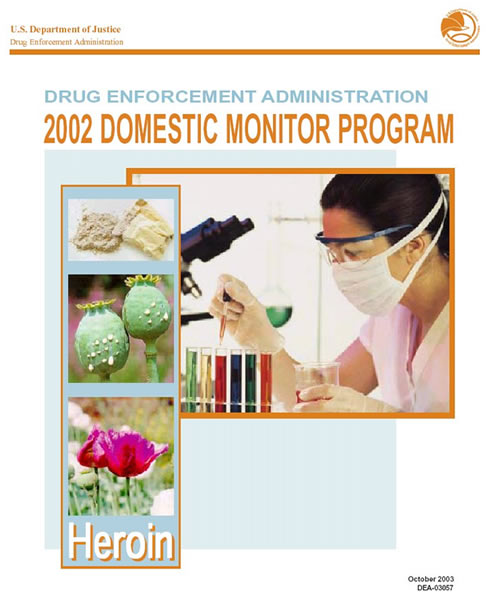
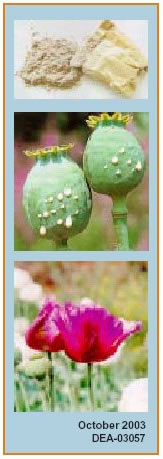 Table
of Contents Table
of Contents
Executive
Summary
Background
2002
DMP Results: Qualified Samples
2002
DMP Results: City by City
Geo-Probes:
A Look at New Cities
Appendix
A: Definitions
Appendix
B: 2000 Heroin Counts, Purities, Prices, and Origin by City
Appendix
C: 2001 Heroin Counts, Purities, Prices, and Origin by City
Appendix
D: 2002 Heroin Counts, Purities, Prices, and Origin by City
Appendix
E: 2002 Heroin Counts, Purities, Prices, Origin, and City by Geographic
Region
Executive
Summary
The Drug Enforcement
Administration’s (DEA) Domestic Monitor Program (DMP) provides data
on the price, purity, and geographic source of heroin being sold at the
retail or street level in 23 U.S. cities. The data contained in this report
are based on actual undercover heroin purchases made by the DEA on the
streets of these cities. Since the inception of the DMP, the program has
documented the rise of heroin purity, and the steady decline of its price
(average price-per-milligram pure) throughout the United States. Additionally,
the DMP has provided information that, in the early to mid-1990s, clearly
showed the infusion of South American heroin into the white-powder heroin
market. Today, South America-produced heroin dominates the white-powder
market east of the Mississippi River, while Mexican black tar and brown
powder heroin clearly dominate the market west of the Mississippi. The
DMP remains an important assessment and analytical tool for the DEA, law
enforcement officials, drug policy makers, and drug abuse researchers
throughout the nation.
Judith
E. Bertini
Acting Assistant Administrator
for Intelligence
Background
The Domestic Monitor
Program (DMP), a retail-level heroin purchase program, provides data on
the price, purity, and geographic origin of street-level heroin available
in major metropolitan areas of the United States to federal, state, and
local law enforcement authorities, drug policy-makers, and drug-abuse
researchers. In 2002, DEA’s Intelligence Division provided funding
for the purchase of retail-level heroin samples in 23 metropolitan areas.
Each heroin purchase subsequently underwent in-depth chemical analyses
at the DEA Special Testing and Research Laboratory (STRL) to determine
the purity and, if possible, the geographic source area (signature analysis)
of the heroin.1
The DMP was initiated
in the New York Field Division in 1979. To this day, New York City DMP
results are particularly important because the city remains the nation’s
largest heroin-user market, and because much of the white powder heroin
available in East Coast markets is obtained there. Between 1979 and 1991,
the number of DEA offices participating in this program fluctuated between
six and 12. In 1991, the DMP was expanded to include one city in every
DEA Field Division. Baltimore, Maryland, was included as a participant
in early 1995; Orlando, Florida, in late 1996; and El Paso, Texas, in
mid-1999.
Since its inception,
the DMP has proven to be a valuable indicator for detecting trends in
retail-level heroin trafficking. For example, in the early to mid-1980s,
the DMP documented the increasing availability of Southeast Asian (SEA)
heroin at the retail level in a number of U.S. cities. In the mid-1990s,
data from the DMP revealed significant increases in the amount of South
American (SA) heroin available at the retail level, particularly in the
metropolitan areas of the northeastern United States.
The goal of the DMP
is to provide federal and other drug policy makers and drug abuse researchers
with information regarding the nature of the domestic heroin problem at
the street level. Additional DMP data analysis reveals changes in heroin
price and purity, adulterants and diluents, use patterns, marketing practices,
availability, and geographic source.
2002
DMP Results: Qualified Samples
DEA offices in each
city where the DMP is conducted are tasked with making 10 street-level
heroin purchases per quarter, or 40 purchases per year. The only exception
is New York City, which makes 20 purchases per quarter, or 80 per year.
As a result, 960 heroin samples should be purchased throughout the year
as part of the DMP; however, the total number of samples included in the
DMP analysis varies from year to year based on a variety of factors. For
example, some exhibits are determined to contain no controlled substance,
some are determined to contain cocaine or other controlled substance,
and some, while containing heroin, do not contain sufficient heroin to
allow for geographic analysis. In other instances, the results of the
geographic analysis are inconclusive. Such samples are not included in
this analysis. Those that are included are “qualified samples,”
meaning that price, purity, and geographic source data are available for
the exhibit. In 2002, 614 qualified samples were purchased. 2
Of these, 341 were classified as SA heroin; 241 were classified as Mexican
(MEX) heroin; 22 were classified as Southwest Asian (SWA) heroin; and
10 were classified as SEA heroin.
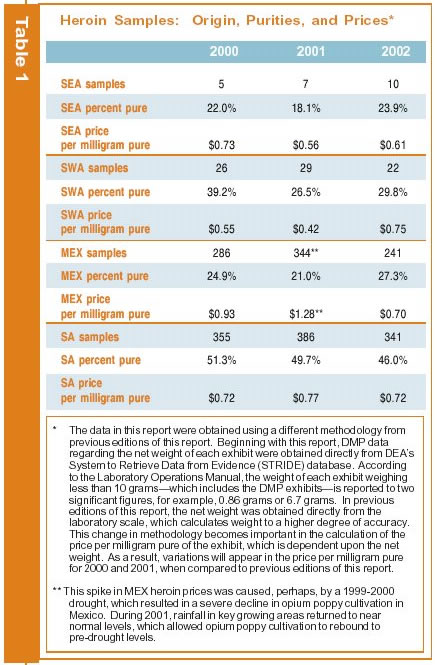
Nationwide, in 2002,
SA heroin samples had the highest average purity—46.0 percent; SEA
heroin had the lowest—23.9 percent. MEX heroin averaged 27.3 percent
pure, and SWA heroin averaged 29.8 percent pure in 2002. Prices per milligram
pure were similar for various types of heroin. At $0.61, SEA samples had
the lowest average price per milligram pure, and SWA samples highest average
price—$0.75 per milligram pure. SA heroin averaged $0.72 per milligram
pure. MEX heroin price averaged $0.70. 2002 numbers for price per milligram
pure are compared to previous years in Table 1.
The price and purity
of SA heroin have been remarkably stable for the past several years. The
price of MEX heroin dropped considerably between 2001 and 2002. However,
the 2002 price is more consistent with the 2000 price level. Due to the
small number of both SWA and SEA exhibits, it is difficult to draw trending
information based on the data.
2002
DMP Results: City by City
Generally speaking,
the heroin market in the United States is divided geographically by the
Mississippi River (See appendix E.). East of the Mississippi River, particularly
in the Northeast where the largest U.S. heroin-user population is located,
SA dominated the market in 2002, as it has in past years. Mexican black
tar and, to a lesser extent, Mexican brown powder heroin dominated markets
west of the Mississippi River. Of the DMP samples that were able to be
classified, 92 percent of those purchased east of the Mississippi River
were SA heroin. West of the Mississippi River, 98 percent of the samples
purchased were classified as MEX heroin.
In 2002, 369 qualified
samples were purchased east of the Mississippi River. Of these 341 were
determined to be SA heroin, six were determined to be SEA heroin, and
22 were SWA heroin. Chicago purchased four SEA exhibits, Atlanta purchased
one, and Washington, DC, purchased one. Eight of the 22 SWA samples were
purchased in the Washington, DC–Baltimore area. The rest were purchased
in Atlanta (4), Chicago (4), Detroit (4), New Orleans (1), and New York
City (1).
West of the Mississippi
River, 245 qualified samples were purchased in 2002; 241 of them were
determined to be MEX heroin. The remaining four were SEA and were purchased
in Dallas, Texas. Interestingly, those four SEA exhibits averaged only
18 percent pure, lower than the national average for SEA of 23.9 percent.
Even though the DMP
is conducted nationwide, the calculation of a national “average”
for price and purity is often misleading, because samples reflect local
user preferences and market availability. As a result, the heroin market
tends to be unique to each metropolitan area, and any attempt to calculate
national averages leads to numbers that do not accurately reflect local
trends. More telling than the changes in the national
averages were the individual changes in purity and average price in the
participating cities in 2002.
Atlanta
Heroin availability
was stable in Atlanta in 2002, where heroin remains a commodity primarily
obtained in the “Bluff” section of the city. In other sections
of Atlanta where heroin was available, intelligence confirmed that the
Bluff was the primary local source of supply. In 2002, 34 qualified samples
were purchased in Atlanta, 29 of which were SA heroin. Four samples were
determined to be SWA and one was SEA. The SWA samples were determined
to be 38.0 percent pure. The SEA exhibit was purchased in December 2002.
It was determined to be 61.4 percent pure. The average purity of the SA
exhibits was 52.4 percent, and ranged in purity from 12.5 percent pure
to 93.8 percent pure.
Baltimore
Heroin plagues the
Baltimore metropolitan area and its outlying suburbs. In fact, both law
enforcement and medical officials in Baltimore consider heroin the city’s
most significant drug problem. The high purity of heroin on the street
level was responsible, at least in part, for a number of heroin-related
hospital emergencies. According to treatment and parole and probation
officials, a large number of these medical emergencies occurred among
newly released prison inmates who were unaware of the increased potency
of the drug, and among inexperienced users. Suburban heroin abusers—particularly
teens and young adults—often traveled into Baltimore to purchase
heroin. Heroin was also purchased on numerous corners in “open-air
markets” of West and East Baltimore in either “raw” (high
purity) or “scramble” (cut) form. Raw heroin was commonly sold
in vials, much like crack
ocaine, and ranged in
purity from over 70 percent to well over 90 percent. Scramble heroin was
available throughout the city, packaged primarily in gelatin capsules. Scramble
heroin ranged in purity from between approximately 10 percent and 20 percent.
In 2002, 26 qualified
purchases were made in Baltimore; 24 of them were SA. The SA exhibits
ranged in purity from 7.1 percent to 82.6 percent and averaged 23.6 percent
pure. On average, the SA exhibits cost $0.38 per milligram pure. The remaining
two exhibits were SWA, averaging 14.2 percent pure and $0.33 per milligram
pure.
Boston
Heroin remained readily
available throughout New England in 2002, selling at low prices and high-purity
levels. At the street level, heroin was routinely distributed in clear
or colored glassine or wax packets with or without markings. Abuse remained
widespread, with continued reports of heroin overdose deaths and other
incidences occurring throughout New England.
In Boston, 27 qualified
samples were purchased in 2002. They were all determined to be SA heroin,
averaging just over 50 percent pure and costing $1.19 per milligram pure.
Chicago
In Chicago, the availability
of heroin, especially of SA heroin, continued to increase during 2002.
However, heroin from other geographic source areas was also available.
In 2002, 27 qualified exhibits were purchased in Chicago: 19 of them were
SA heroin; 4 were SEA heroin; and 4 were SWA heroin. The SA heroin exhibits
averaged 20.4 percent pure; the SEA heroin exhibits averaged 20.8 percent
pure; and the SWA heroin exhibits 19.8 percent pure. These purity levels
suggest a high degree of niformity in the heroin market in Chicago. The
average price per milligram pure for SA heroin was $0.43; for SEA heroin
$0.71; and for SWA heroin $0.39.
The 15th Police District
in Chicago has the highest concentration of open-air heroin sales locations
in the city. Street gangs control virtually all of these locations. Retail
sellers compete with one another on almost every street corner for customers.
Many of the customers are young and white from affluent, middle-class
Chicago suburbs. The Chicago Police Department estimates that approximately
two-thirds of the heroin seized in the city originated in this district
and the neighboring 11th District. Because these areas have been identified
as the most active heroin retail-sales markets in the city, the majority
of the DMP purchases made in the past several years, including in 2002,
have occurred in these two districts.
Dallas
In 2002, MEX heroin
remained the most readily available type of heroin in Dallas, accounting
for 29 of the 33 qualified samples purchased as part of the DMP. However,
white heroin has begun to appear in this market. In 2000, no SEA heroin
purchases were made in Dallas. In 2001, five such purchases were made.
In 2002, four SEA heroin samples were purchased. They averaged 18 percent
pure and cost $0.46 per milligram pure. Analysis of these samples, however,
determined that three of them were purchased on the same date and were
chemically identical. The MEX heroin samples averaged 17.2 percent pure
and cost $0.75 per milligram pure.
Denver
The majority of heroin
sales in Denver have traditionally taken place in the lower downtown area.
Street-level weight is usually sold in grams, selling from $100 to $150.
MEX heroin was the only type encountered in the DMP in Denver in 2002.
All 23 qualified samples were MEX heroin. The samples averaged 18.4 percent
pure, ranging from 11.8 to 29.3 percent pure. On average, the samples
cost $1.12 per milligram pure, among the highest prices in the western
region.
Detroit
In 2002, SA heroin
accounted for 12 of the 16 qualified samples purchased in Detroit. Those
12 samples averaged 45.8 percent pure and cost $0.80 per milligram pure.
The remaining four exhibits were SWA heroin, averaging 41.7 percent pure
and costing, on average, $0.62. Chemical analysis determined that two
of the SWA heroin exhibits were identical; these two exhibits were purchased
2 days and nearly 5 miles apart.
El
Paso
Heroin is readily
available in the El Paso metropolitan area and can be purchased city-wide
for $100 per gram. In 2002, only seven qualified samples were purchased
in El Paso. They were all MEX heroin, averaging 40.3 percent pure and
$0.27 per milligram pure.
Houston
Intelligence information
indicates that the demand for Mexican brown powder heroin declined in
the Houston area in 2002. Some heroin users bypassed other heroin sources
of supply, and specifically requested white heroin. In November 2002,
local police officers arrested a Hispanic male in downtown Houston who
was in possession of approximately 1 ounce of white heroin. Laboratory
analysis revealed the heroin was at least 87 percent pure, which is more
than three times the purity level normally found at the street level in
Houston.
Additional information
indicates that the following areas are common street-level distribution
sites in Houston:
- The East End,
near Canal and Navigation Streets
-
The Greenspoint area
- The Washington
Street area
- The North Main
Street area
- The Yellowstone
area
- Pasadena, Texas
Prices in Houston
ranged from $20 for street-level quantities of heroin, $500 for ¼
ounce, and between $1,600 and $2,000 for an ounce. In 2002, 39 qualified
samples were purchased in Houston. All were MEX heroin. They averaged
28.2 percent pure and cost $0.64 per milligram pure. The Houston exhibits
ranged from 3.7 to 58.8 percent pure. One exhibit contained heroin at
13.9 percent and cocaine at 4.5 percent.
Los
Angeles
In 2002, 28 qualified
samples were purchased in Los Angeles. All were MEX heroin, averaging
26.5 percent pure and costing $0.30 per milligram pure. The exhibits ranged
in purity from 9.0 to 50.1 percent.
Miami
Twenty-nine qualified
samples were purchased in Miami in 2002. All 29 were SA heroin. They averaged
29.4 percent pure and cost $0.61 per milligram pure. Three of the Miami
exhibits contained cocaine: two as a trace substance and one at 0.64 percent.
New
Orleans
In 2002, 23 qualified
samples were purchased in New Orleans; 22 were determined to be SA heroin
at 30.4 percent pure and $1.65 per milligram pure. The remaining exhibit
was SWA heroin. It was determined to be 40 percent pure and to cost $1.14
per milligram pure. In 2001, one SWA heroin appeared in the New Orleans
DMP. It was determined to be 45.4 percent pure and to cost $0.37 per milligram
pure.
New
York City
New York City is
one of the most significant heroin destination and distribution centers
in the United States. In 2002, heroin was readily available from the various
ethnic groups that comprise metropolitan New York City’s demographic,
while prices were stable and purity high. SA heroin was the most common
type of heroin encountered in New York City in 2002. In fact, of the 61
qualified exhibits purchased in 2002, 60 were SA heroin. Analysis revealed
they averaged 61.5 percent pure and cost $0.36 per milligram pure, the
lowest price in the nation for SA heroin. The remaining exhibit was SWA
heroin at 56.8 percent pure and $0.23 per milligram pure. In 2001, two
samples of MEX heroin were purchased as part of the DMP. No such atypical
purchases were made in New York City in 2002.
Newark
In 2002, 27 qualified
samples were purchased in Newark; all were SA heroin. Those exhibits were
analyzed to be 71.4 percent pure and to cost $0.39 per milligram pure.
That purity level led the nation in 2002, and the price per milligram
pure was among the lowest for SA heroin.
Orlando
Orlando’s heroin
market was very uniform in 2002—all 29 qualified exhibits were SA
heroin. Those exhibits were analyzed to be 46.1 percent pure and to cost
$0.63 per milligram pure.
Philadelphia
SA heroin remained
widely available throughout Philadelphia during 2002. Although the greater
Philadelphia area is generally considered a consumer market for sources
in New York City and Miami, the availability of cheap, high-purity, SA
heroin in Philadelphia and, in particular, the “Badlands” of
North Philadelphia, continued to attract lower-level distributors and
users from other states and localities to Philadelphia’s street-corner
distribution locations. The increased availability of cheaper, higher-purity
heroin over the last few years has caused concern throughout Pennsylvania
over a growing heroin use problem that reaches all areas and all socioeconomic
backgrounds. Heroin’s popularity among teens and young adults remained
high, as they and other users consumed heroin either by itself or in combination
with cocaine or alcohol, a combination that typically leads to overdose
deaths. In some areas, heroin overdose deaths have continued to rise in
the last few years. For example, the Lackawanna County Coroner’s
Office reported only 13 drug overdose deaths combined in 1998 and 1999;
in 2000, 31 fatal drug overdoses were reported; and in 2001, 22 heroin
overdose deaths were reported. Through June 2002, there were 22 heroin
overdose deaths reported in Lackawanna County. Similarly, in Lehigh and
Northampton Counties, all but one of the drug overdose fatalities were
caused by either heroin by itself or heroin in combination with other
substances. However, in Allegheny County (western Pennsylvania), the number
of heroin overdose deaths continued its decline in 2002 after nearly tripling
between 1997 and 2001.
In 2002, heroin purity
levels in Philadelphia were among the highest in the nation. Based on
the analysis of the 24 qualified exhibits, all of which were SA heroin,
the average purity of heroin in Philadelphia was 66.3 percent, and the
average cost was $0.42 per milligram pure.
Phoenix
MEX heroin dominated
the market in Phoenix in 2002; all 29 qualified exhibits were determined
to be MEX heroin. Those exhibits were analyzed to be 48.9 percent pure,
a purity level that led the western region in 2002. Analysis also determined
that the DMP samples in Phoenix cost $0.51 per milligram pure. Table 2
provides a brief overview of heroin purity levels in Phoenix since 2000.
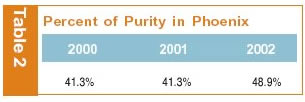
San
Diego
MEX heroin was readily
available in Imperial County, as well as San Diego in 2002. In fact, MEX
heroin accounted for all 30 qualified samples purchased in San Diego as
part of the DMP in 2002. Those exhibits were analyzed to be 47.9 percent
pure, a purity level that ranked second only to Phoenix in the western
region. Analysis of the San Diego samples determined their cost to be
$0.24 per milligram pure, the cheapest in the western region.
San
Francisco
MEX heroin remained
readily available throughout this region, specifically in San Francisco’s
Mission, Tenderloin, Bayview, Bernal Heights, and Portrero Hill Districts.
Supplies were also readily available in San Leandro (in Alameda County)
and throughout Sonoma County. User quantities of black tar heroin, the
heroin of choice throughout the region, were usually packaged in double
plastic bags. The DMP results bear this out—all of the 22 qualified
samples purchased in San Francisco in 2002 were determined to be MEX heroin.
Those exhibits were analyzed to be 12.1 percent pure and to cost $0.99
per milligram pure.
San
Juan
Heroin was readily
available in all areas of Puerto Rico in 2002, and was the most widely
abused drug in eastern Puerto Rico, particularly in the Fajardo area.
The most common areas for buying heroin were the drug “points”
in the public housing projects and barriadas (marginal neighborhoods).
Intravenous injection was the primary means of ingestion. However, a small
number of addicts snorted the drug, sometimes mixed with cocaine, in a
combination known as a “spitball.” SA heroin dominated the market
in Puerto Rico and all 27 of the qualified exhibits purchased as part
of the DMP in 2002 were determined to be SA heroin. They averaged 36.7
percent pure and cost $0.48 per milligram pure.
Seattle
MEX heroin dominated
the market in Seattle in 2002, accounting for all 16 of the qualified
samples purchased there. Those exhibits were analyzed to be 10.5 percent
pure, the lowest purity level in the nation, and to cost $0.89 per milligram
pure. The number of needles exchanged at needle exchange program sites
provides an indication of the high demand for heroin in the Puget Sound,
Washington, and Lane County, Oregon regions. Many of these needles are
used for heroin injections, although they can also be used for methamphetamine,
insulin, or any other injectable substance. Table 3 shows the number of
needles exchanged in King (Seattle) and Pierce (Tacoma) Counties each
year since 1998, and the number of needles exchanged in Lane County (Eugene,
Oregon) each fiscal year since 2000.
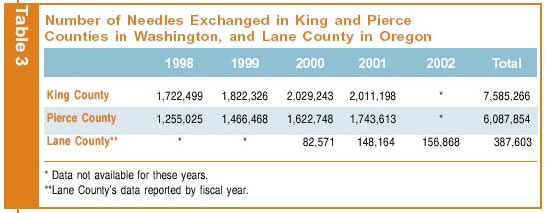
St.
Louis
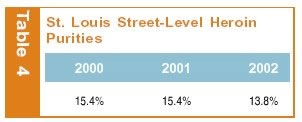
Heroin abuse and
trafficking continued to be a growing concern in the St. Louis area in
2002. Mexican black tar heroin was readily available in the depressed
urban areas of St. Louis, and it represented all 18 of the qualified exhibits
purchased by the DMP in 2002. Those exhibits were analyzed to be 13.8
percent pure, and to cost $1.54 per milligram pure. Heroin is typically
sold in “buttons” for $10. Eight to 10 buttons weigh a gram
and the heroin is brought into the area from California, Arizona, Texas,
and Chicago, Illinois. A comparison of DMP data for St. Louis, from 1994
to 1998, shows a nearly three-fold increase in the overall purity of street-level
heroin; however, since 2000, street-level heroin purities have remained
stable, as reflected in Table 4.
Washington,
DC
The heroin market
in Washington, DC, where the heroin trade is well entrenched, was one
of the most varied markets in the DMP in 2002. Nineteen qualified exhibits
were purchased as part of the DMP. Of that number, 12 were SA heroin,
one was SEA heroin, and six were SWA heroin. The 12 SA heroin samples
averaged 20.8 percent pure, and cost $0.79 per milligram pure. The SEA
heroin exhibit was 22.7 percent pure, and cost $0.46 per milligram pure.
The six SWA heroin exhibits averaged 22.2 percent pure, and cost an average
of $0.47 per milligram pure.
The 14th Street corridor
in Northwest Washington, DC, is a magnet for suburban users purchasing
high-purity heroin. Distributors in other areas of the District—particularly
the eastern quadrants—continue to supply heroin ranging in purities
from less than 10 percent to 25 percent. The eastern part of the city
was frequented more by well-established sellers and long-term addicts
than by suburban users. These neighborhoods experienced a higher volume
of trafficking and, therefore, higher levels of associated violence. Washington,
DC, Metropolitan Police Department officials also attribute lower levels
of violence, in the Northwest corridor and other high-purity heroin distribution
areas, to a different mentality on the part of heroin distributors there,
who “serve up” heroin to primarily white, suburban customers.
According to officials, distributors in these areas “take care of”
their customers, who tend to spend several hundred dollars at a time,
in order to maintain a regular profit.
 Geo-Probes:
A Look at New Cities Geo-Probes:
A Look at New Cities
Beginning in 2001,
DEA began a new initiative within the DMP called Geographical Probes,
or Geo-Probes. The purpose of the Geo-Probes is to gain additional intelligence
about existing and emerging heroin markets in areas outside the traditional
DMP areas. In order to accomplish that mission, DEA made funds available
for sample heroin purchases in selected cities across the United States.
In 2002, those cities were: Huntington Park, California; Broward County,
Florida; Holyoke and Worcester, Massachusetts; Warren-Youngstown, Ohio;
Eugene-Springfield, Oregon; Austin, Texas; Corpus Christi and Robstown,
Texas; Laredo, Texas; and Milwaukee, Wisconsin.
Holyoke
and Worcester, Massachusetts
Holyoke and Worcester
are source centers for high-quality heroin for surrounding cities and
towns in western Massachusetts and Vermont. Numerous overdose deaths and
incidents have been attributed to heroin obtained from these areas. In
order to determine the purity and the geographic origin of the heroin
available in these areas, a Geo-Probe was conducted there during August
and September 2002. Five heroin purchases were made, and all five qualified
samples determined to be SA heroin. They averaged 49.8 percent pure, and
cost, on average, $0.84 per milligram pure. DMP purchases in nearby Boston
averaged 50.3 percent pure, and cost $1.19 per milligram pure, perhaps
an indication of a New York City-based source of supply. In New York City,
SA heroin averaged 61.5 percent pure, and sold for $0.36 per milligram
pure in 2002.
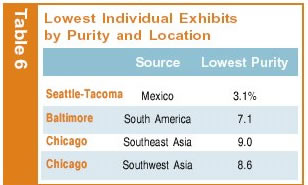 Milwaukee,
Wisconsin Milwaukee,
Wisconsin
Intelligence information
in 2002 indicated that Milwaukee had a significant heroin presence around
the inner city area, with purity levels occasionally rising to the 60-90
percent range. In order to develop further intelligence regarding this
market, a Geo-Probe was conducted in Milwaukee in May and June 2002. This
Geo-Probe resulted in the purchase of five exhibits. Unfortunately, only
two of them were qualified samples. Those two samples were both determined
to be SA heroin at more than 70 percent pure. They cost, on average, $0.33
per milligram pure. Despite the limited number of qualified samples, the
results of this Geo-Probe are compelling in that the average purity of
samples in Milwaukee was significantly higher than purity levels in nearby
Chicago, which has long been identified as a source city for Milwaukee.
In addition, heroin in Milwaukee costs less, on average, than heroin in
Chicago. Further information regarding the comparison of prices and purities
for SA heroin in Milwaukee, Chicago, and Detroit is detailed in Table
7.
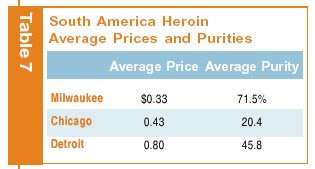 Warren-Youngstown,
Ohio Warren-Youngstown,
Ohio
In response to numerous
overdose deaths in the Warren-Youngstown area, four heroin purchases were
made in that area during May and June 2002, as part of the Geo-Probe program.
All four purchases were qualified samples and were determined to be SA
heroin, which averaged 48.1 percent pure and $1.42 per milligram pure.
Purity levels in Warren are consistent with those in Detroit, but prices
are higher, indicating that heroin sources of supply may be based in Detroit.
Austin,
Texas
In order to gather
intelligence on the street-level heroin trade in this college town, a
Geo-Probe was conducted in Austin during June 2002. Five heroin exhibits
were purchased and all five were qualified samples of MEX origin. They
averaged 20.5 percent pure. Two of the exhibits were just over 6 percent
pure. The remaining four exhibits, however, averaged just over 30 percent
pure, suggesting broad fluctuations in the market that could be dangerous
for new users.
Corpus
Christi and Robstown, Texas
In December 2002,
a Geo-Probe was initiated in Corpus Christi-Robstown after a rash of heroin
overdose deaths in that area. Intelligence information indicated that
MEX brown powder was the heroin of choice in the Corpus Christi area,
and purity levels were generally low. Information obtained from the Geo-Probe
confirms this intelligence. Heroin prices averaged from $20 for a “hit”
to $70 for a gram of MEX brown powder heroin. Four heroin exhibits were
purchased as part of the program, and three of them were determined to
be MEX heroin. Those three samples averaged 6.83 percent pure.
Laredo,
Texas
In mid-August 2002,
four individuals—three of them teenagers—died from heroin overdoses.
The youngest victim, a 13-year-old girl, also tested positive for cocaine,
opiates, and marijuana. All of the victims lived in the same area of Laredo.
Two of the victims were known heroin users, and one still had the needle
sticking in his arm. This spate of overdose deaths led to the initiation
of a Geo-Probe in this area. Six heroin purchases were made between August
and December 2002. Five of those purchases were determined to be MEX heroin,
averaging 57.6 percent pure. Four of those exhibits were more than 60
percent pure. Interestingly, the only exhibit for which a geographic origin
could not be determined contained heroin at 8.3 percent pure and cocaine
at 73.7 percent.
[Note: Taken together,
the three Geo-Probes conducted in south Texas resulted in the purchase
of 13 qualified exhibits, averaging 31.6 percent pure, and costing $0.69
per milligram pure.]
Huntington
Park, California
In response to a
report of high-purity heroin being sold at the retail level in Huntington
Park, a Geo-Probe was conducted there in November and December 2002. Five
heroin purchases were made, and all five were determined to be MEX heroin.
They averaged 25.8 percent pure and $0.29 per milligram pure. Even though
the average price and purity are consistent with price and purity levels
for Los Angeles, one Geo-Probe purchase was determined to be 49.1 percent
pure, confirming the intelligence that led to the probe.
Broward
County, Florida
A significant increase
in overdose deaths in Broward and Palm Beach Counties led to the initiation
of a Geo-Probe in Broward County in September and October 2002. Five heroin
exhibits were purchased as part of that program; however, only two of
those exhibits were qualified samples. The qualified samples were determined
to be SA heroin at 17.4 percent pure, costing $0.76 per milligram pure.
The remaining samples were determined to contain cocaine.
Eugene
and Springfield, Oregon
In response to a
report of street-level heroin prices dropping to $30 per gram in this
area, a Geo-Probe was conducted in Eugene and Springfield in June 2002.
Five heroin exhibits were purchased, and all were determined to be MEX
heroin, averaging 10.8 percent pure and $0.67 per milligram pure. Those
numbers are similar to price and purity levels in Seattle. Unfortunately,
three of the exhibits were purchased on the same date, in the same general
area, and chemical analysis revealed them to be identical.
Appendix
A: Definitions
Adulterants:
Pharmacologically active substances, such as caffeine, mono-acetylmorphine,
procaine, and quinine, which remain in, or are added to, the final heroin
product at the completion of the heroin conversion process.
Composite
Samples:
A limited number of samples can be identified as being part of the same
batch and/or as having been purchased from the same dealer(s), based on
laboratory analyses and the date and location of the purchases. Samples
of this type are combined to form a composite.
Diluents:
Pharmacologically inactive substances, such as lactose, mannitol, starch,
and sucrose, added to increase bulk.
Heroin
Signature Analysis: A
program developed by the DEA to identify the geographic source area of
a heroin sample. Heroin Signature Analysis is based on an exhaustive chemical
profile of authentic samples acquired from each of the four major heroin
source areas: South America, Mexico, Southeast Asia, and Southwest Asia.
Heroin
Signature Classification:
The result of heroin signature analysis. Classifications currently defined
include South American (SA), Mexican (MEX), Southeast Asian (SEA), and
Southwest Asia (SWA) heroin. Samples meeting these classifications are
referred to as qualified samples. When the results of a signature analysis
are inconclusive, the sample may be listed as “unknown” or “insufficient
weight.”
Insufficient
Weight: A
sample of heroin that is too small for signature analysis. Generally, an
exhibit should weigh at least 1 gram net, including diluents and adulterants.
This amount ensures that there are at least 45 milligrams of pure heroin
available for signature analysis.
Net
Weight:
The total weight of the heroin exhibit, including diluents and adulterants,
excluding its packaging.
Price
Per Milligram Pure:
The price of the sample divided by the pure weight expressed in milligrams.
Pure
Weight:
The weight of the pure heroin determined by multiplying the purity of
a sample by its net weight.
Purity:
The amount of heroin present compared to all other substances in the sample.
Purity is expressed as a percent.
Qualified
Sample:
A heroin sample that is able to be analyzed and classified by the STRL
for source.
Unknown:
A sample of heroin analyzed by the STRL, but for which the result of the
analysis does not match any of the standard classifications (See Heroin
Signature Classification).
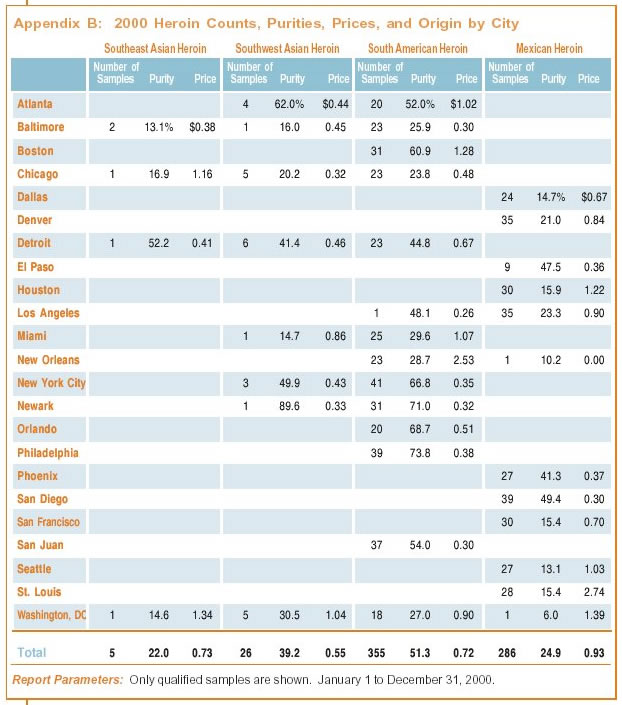
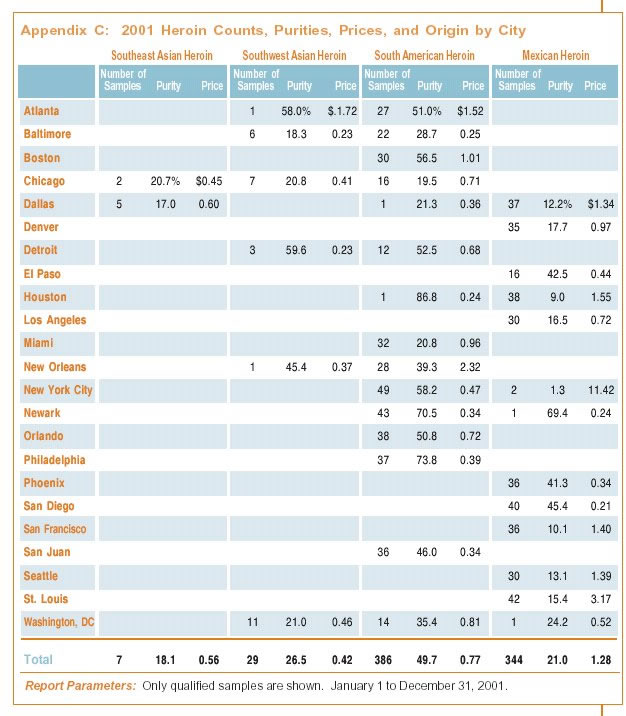
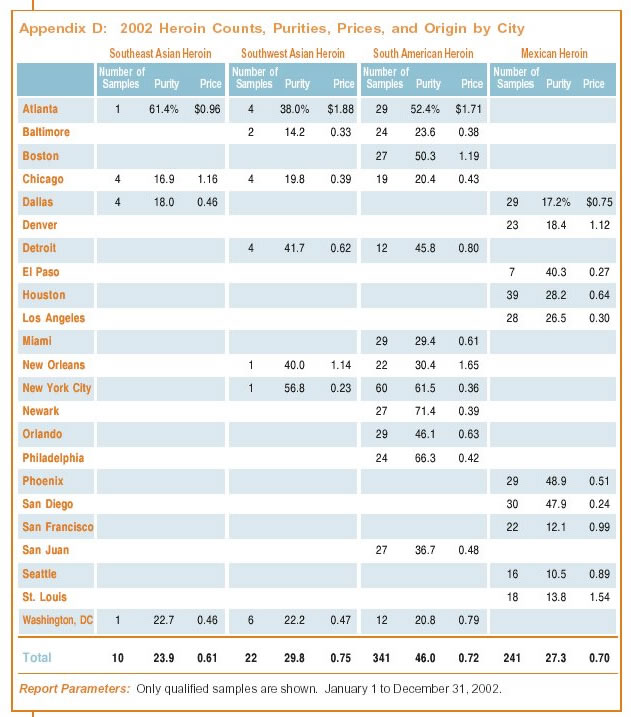
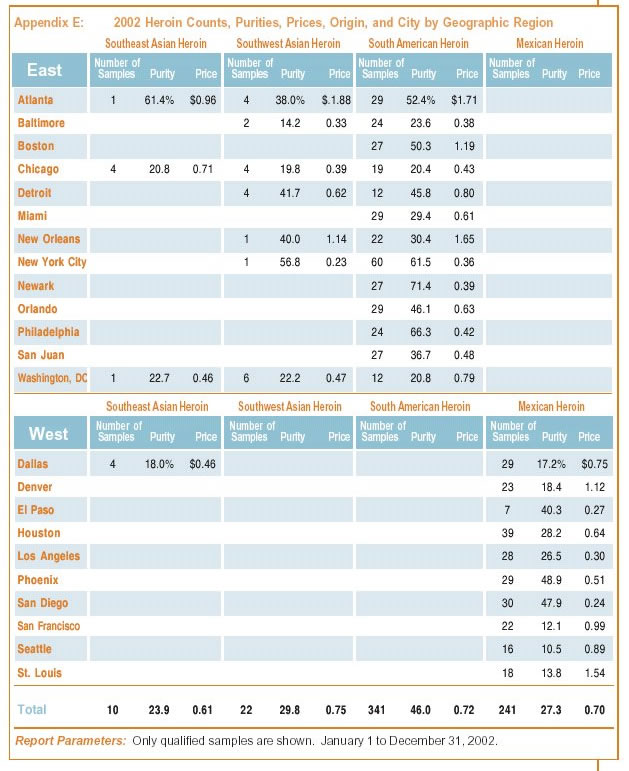
1For
an explanation of signature analysis and other terms used in this report,
see appendix A
2 The final quarter of calendar year (CY) 2002 coincided
with the first quarter of Fiscal Year (FY) 2003 because, at that time,
DEA was operating under a Continuing Resolution, and DMP purchases were
not funded in most cities. As a result, fewer total samples were purchased
in 2002; and therefore, fewer qualified samples were available for inclusion
in this report.
| This report was
prepared by the Domestic Strategic Intelligence Unit of the Special
Strategic Intelligence Section of the Office of Strategic Intelligence.
This report reflects information received prior to September 2003.
Comments and requests for copies are welcome and may be faxed to the
Intelligence Production Unit, Intelligence Division, DEA Headquarters,
at (202)307-8726. |
DEA-03057
|

